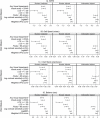Relationship of Self-reported and Performance-based Visual Function With Performance-based Measures of Physical Function: The Health ABC Study
- PMID: 36346340
- PMCID: PMC10613017
- DOI: 10.1093/gerona/glac225
Relationship of Self-reported and Performance-based Visual Function With Performance-based Measures of Physical Function: The Health ABC Study
Abstract
Background: To assess the relationship between self-reported and performance-based visual impairment (VI) and lower extremity physical function.
Methods: Cross-sectional analysis of 2 219 Health ABC participants who completed vision testing and the Short Physical Performance Battery (SPPB). Linear regression models used either self-reported (weighted visual function question [VFQ] score) or performance-based (visual acuity [VA], log contrast sensitivity [LCS], Frisby stereoacuity [SA]) to predict SPPB or its components-gait speed, chair stands, or standing balance-with and without covariate adjustment.
Results: Mean age was 73.5 years (range 69-80); 52.4% were female and 37.4% African American. All VI measures were strongly associated with SPPB in unadjusted and adjusted models (p < .001). A self-reported VFQ score 1 standard deviation lower than the mean (mean 87.8 out of 100) demonstrated a -0.241 (95% confidence interval [CI]: -0.325, -0.156) adjusted difference in SPPB. After controlling for covariates, VA of <20/40 (41%) demonstrated a -0.496 (-0.660, -0.331) lower SPPB score while SA score>85 arcsec (30%) had a -0.449 (-0.627, -0.271) adjusted SPPB score versus those with better visual function. LCS < 1.55 (28.6%) was associated with a -0.759 (-0.938, -0.579) lower and LCS ≤ 1.30 (8%) with a -1.216 (-1.515, -0.918) lower adjusted SPPB score relative to better LCS. In a final multivariable model containing multiple vision measures, LCS remained independently associated with SPPB and all components, while SA remained associated with balance (all p < .05).
Conclusions: Both self-reported and performance-based VI are strongly associated with poor lower extremity physical function. These findings may identify a subgroup of older adults with co-existing visual and physical dysfunction who may benefit from targeted screening and intervention to prevent disability.
Keywords: Balance; Contrast sensitivity; Gait speed; Stereoacuity.
© The Author(s) 2022. Published by Oxford University Press on behalf of The Gerontological Society of America. All rights reserved. For permissions, please e-mail: journals.permissions@oup.com.
Conflict of interest statement
None declared.
Figures

Similar articles
-
Community screening for visual impairment in older people.Cochrane Database Syst Rev. 2018 Feb 20;2(2):CD001054. doi: 10.1002/14651858.CD001054.pub3. Cochrane Database Syst Rev. 2018. PMID: 29460275 Free PMC article.
-
Visual impairment predicts greater declines in physical performance over time: the Health, Aging and Body Composition Study.BMC Geriatr. 2025 Mar 14;25(1):176. doi: 10.1186/s12877-025-05747-6. BMC Geriatr. 2025. PMID: 40087588 Free PMC article.
-
Prescription of Controlled Substances: Benefits and Risks.2025 Jul 6. In: StatPearls [Internet]. Treasure Island (FL): StatPearls Publishing; 2025 Jan–. 2025 Jul 6. In: StatPearls [Internet]. Treasure Island (FL): StatPearls Publishing; 2025 Jan–. PMID: 30726003 Free Books & Documents.
-
Comparison of Two Modern Survival Prediction Tools, SORG-MLA and METSSS, in Patients With Symptomatic Long-bone Metastases Who Underwent Local Treatment With Surgery Followed by Radiotherapy and With Radiotherapy Alone.Clin Orthop Relat Res. 2024 Dec 1;482(12):2193-2208. doi: 10.1097/CORR.0000000000003185. Epub 2024 Jul 23. Clin Orthop Relat Res. 2024. PMID: 39051924
-
Short Physical Performance Battery and all-cause mortality: systematic review and meta-analysis.BMC Med. 2016 Dec 22;14(1):215. doi: 10.1186/s12916-016-0763-7. BMC Med. 2016. PMID: 28003033 Free PMC article.
Cited by
-
Novel anthropometric indices are superior adiposity indexes to portend visual impairment in middle-aged and older Chinese population.BMJ Open Ophthalmol. 2024 Jul 15;9(1):e001664. doi: 10.1136/bmjophth-2024-001664. BMJ Open Ophthalmol. 2024. PMID: 39009464 Free PMC article.
-
The relationship between visual function and physical performance in the Study of Muscle, Mobility and Aging (SOMMA).PLoS One. 2023 Sep 27;18(9):e0292079. doi: 10.1371/journal.pone.0292079. eCollection 2023. PLoS One. 2023. PMID: 37756354 Free PMC article.
-
Visual contrast sensitivity is associated with community structure integrity in cognitively unimpaired older adults: the Brain Networks and Mobility (B-NET) Study.Aging Brain. 2024 Jul 24;6:100122. doi: 10.1016/j.nbas.2024.100122. eCollection 2024. Aging Brain. 2024. PMID: 39148934 Free PMC article.
-
Association Between Contrast Sensitivity and Physical Function in Cognitively Healthy Older Adults: The Brain Networks and Mobility Function Study.J Gerontol A Biol Sci Med Sci. 2023 Aug 2;78(8):1513-1521. doi: 10.1093/gerona/glad060. J Gerontol A Biol Sci Med Sci. 2023. PMID: 36800312 Free PMC article.
-
Contrast Sensitivity Predicts 30-month Functional Brain Network Integrity in Cognitively Unimpaired Older Adults: the Brain Networks and Mobility Study.J Gerontol A Biol Sci Med Sci. 2025 Jun 10;80(7):glaf098. doi: 10.1093/gerona/glaf098. J Gerontol A Biol Sci Med Sci. 2025. PMID: 40326425 Free PMC article.
References
-
- GBD 2019 Blindness and Vision Impairment Collaborators; Vision Loss Expert Group of the Global Burden of Disease Study. Causes of blindness and vision impairment in 2020 and trends over 30 years, and prevalence of avoidable blindness in relation to VISION 2020: the Right to Sight: an analysis for the Global Burden of Disease Study. Lancet Glob Health 2021;9(2):e144–ee60. doi: 10.1016/S2214-109X(20)30489-7 - DOI - PMC - PubMed
Publication types
MeSH terms
Grants and funding
LinkOut - more resources
Full Text Sources
Medical

